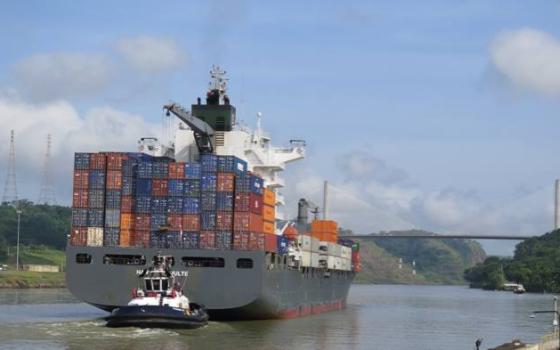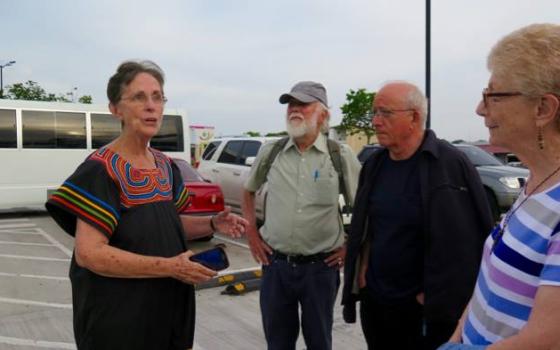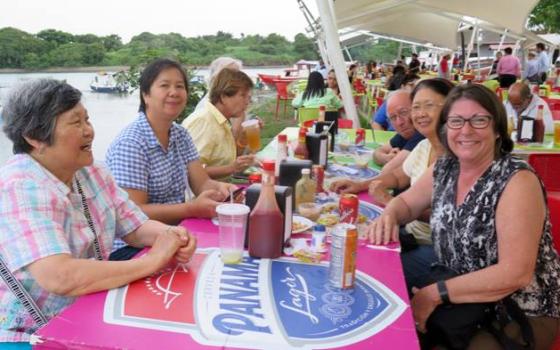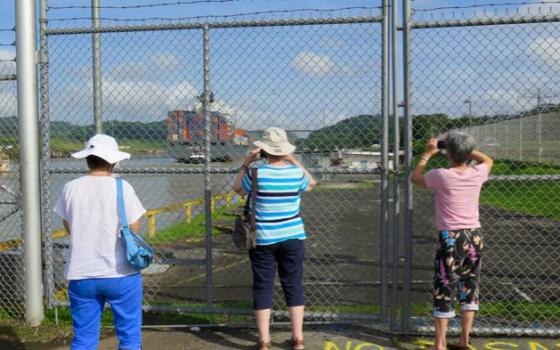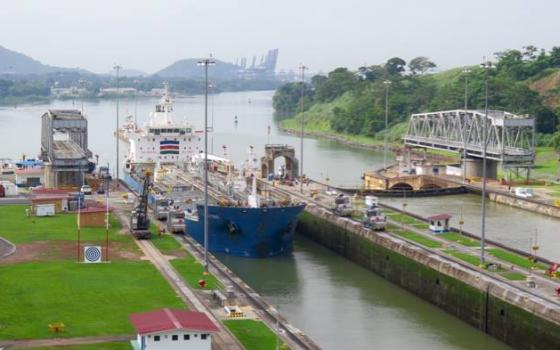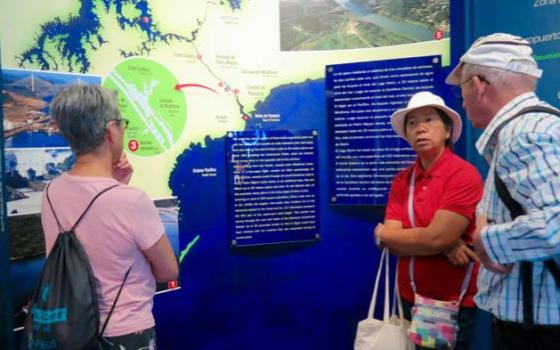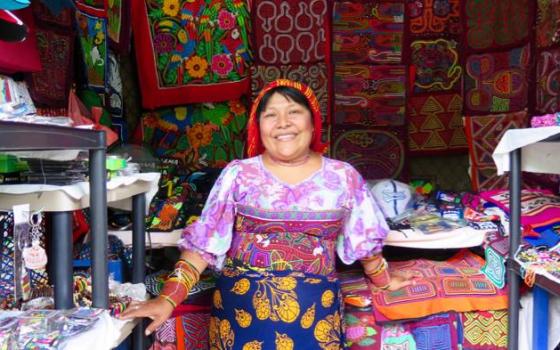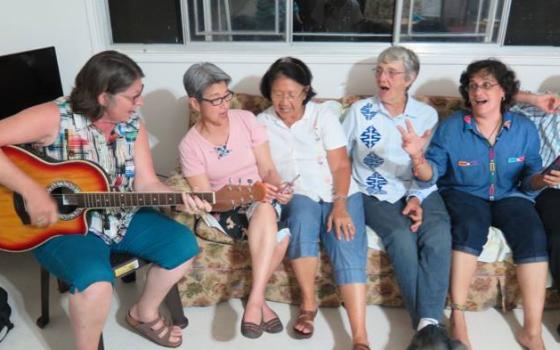"Contemporary science is crafting a dynamic picture of how the universe came to be. From the initial flaring forth of the Big Bang some 13.8 billion years ago, to the formation galaxies with their billions of stars ... to the slow evolution of life on Earth over deep eons of time, the cosmic adventure has moved toward increasing complexity and beauty. We humans who emerged from this cosmic process a mere speck of time ago are now conscious of this history. This makes us, in Rabbi Abraham Heschel's beautiful words, 'the cantors of the universe,' those creatures who can give praise to the Creator with and in the name of all the rest."
- Elizabeth A. Johnson, Abounding in Kindness: Writings for the People of God
After four hours of Pan-American Highway, the green forested corridor and cattle ranches of Darién were now far behind us. We crossed over a struggling remnant of mangrove forest, and suddenly, Panama's skyline loomed in front of us, including Trump Tower and corporate headquarters from around the world. A river of traffic shocked the senses after a week in the quiet of the countryside.
Maryknoll Sr. Gerri Brake had arranged to meet us in El Chorrillo, not far from Balboa, the neighborhood where the Maryknoll Sisters had been in mission. In 1989, they were there on that night in December when the bombs began to fall on El Chorrillo. The U.S. military called it Operation Just Cause; Panamanians call it the U.S. invasion.
No one really knows how many died in the invasion intended to overthrow dictator Manuel Noriega; some say 5,000. Balboa High School became a refugee camp, and Brake and other Maryknoll sisters worked day and night to help ease the pain and the terror of the wounded.
Nowadays, El Chorrillo is part of the Cinta Costera, the new landscaped highway project that brought redevelopment and a measure of prosperity to the area. We ended up at Sabores del Chorrillo, a restaurant on the waterfront. Here, the ladies who used to sell their fish on the streets now have an upscale restaurant, and this was where the group landed on our first night back in civilization.
The Panama Canal, the highlight of our last day, was a study in contradictions after the full immersion in the natural world of Darién. The massive size of the undertaking, one of the most audacious engineering feats of the 20th century, inspires awe. The group watched from the platform as ships the size of a village slowly passed through the lock below.
In the context of the Web of Life, however, I think beyond this place and this moment, where 3,000 people will visit with their cameras and iPhones and take selfies in front of the moving machines. I think of the 30,000 people who died in the creation of this canal. I think of the mountains moved, the thousands of acres of forests flooded and wetlands drained, and the millions of gallons of fresh water being flushed into the sea with the movement of every ship.
Javier Pimentel, our guide, shared a few numbers that put things into perspective. Each lock is the height of an eight-story building. Each ship must be lifted 85 feet through the introduction into three of these locks, then lowered through another set of locks to cross what is left of the mountain range. Fifty-two million gallons of fresh water are required to move each ship that passes through; 35 to 40 ships pass each day. Ships pay from $800 for a small sailboat to $1 million for a massive container ship.
"That one cost $120,000," he said, pointing to the one in front of us. The one on the horizon in the new expanded canal paid $650,000, he said. The Panamanian government collected $1.6 billion from the canal last year, Pimentel told us.
The new $5.5 billion canal expansion opened a year ago to great fanfare. Already, it has exceeded expectations, with six ships passing through each day when only three were expected, Pimentel said.
Now, there is already talk of channeling a nearby river and making yet another expansion, as there are new ships that even the expanded canal channel cannot accommodate, Pimentel told us.
The group explored the three-story museum detailing the story of the canal. During Pimentel's presentation, amid the racket from the locks and the crowd, David Molineaux, caught up in the awe of admiration for sheer scale and accomplishment of the canal project, noticed a pair of birds on the railing above the stairway, one of them in a piece of straw in its beak.
"It struck me how amid all of this great work of engineering, a pair of birds were in the process of planning their nest," he said.
Claretian Fr. José Maria Vigil said he was struck by the contrast between the canal and the story told at the Biomuseo, just a couple of miles down the road, where Panama's role as the biological bridge of the Americas is celebrated.
"It's a great contradiction. Now we have the great broken bridge of the world," he said. "Here, we're seeing a new biological rupture. It's an enormous gap, and most terrestrial life cannot cross."
Maryknoll Sr. Ann Braudis contemplated the contradictions, as well. On the one hand, the canal is a great civilizational achievement, she said.
"When it was first completed, our technology and our capacity as human beings to moderate the Earth in order to serve our purposes seemed like real progress; that was the direction we were meant to go in," she said. "However, in recent times, we recognize that technology is leading us to the very destruction of the planet that supports us. And for that reason, we come into awareness of the fact that we may no longer do everything that we know how to do."
After the canal visit, some of the group went to an artisan market and visited with members of the indigenous Kuna tribe. Brake introduced us to her longtime friend Rosa Lidia Alba from the island of Ailigandi in the Kuna comarca, or territory.
Back at the Maryknoll sisters' house in Panama Pacifíco, the group gathered in a final circle of reflection. Hearts opened wide with the sharing, and tears flowed. Bonds had been formed, insights explored, consciousness expanded. Scientists and people of faith had found common ground.
Clara Meza shared a moment of realization she had as she left the mission in Darién.
"I was crossing the same path I always cross, and suddenly, I saw two spider monkeys in the trees above me," she said. "They had always been there, but I had never seen them. I realize that now I am seeing with new eyes."
For Itzel Menéndez, who had never even dreamed of visiting the wilderness of Darién, the whole experience was eye-opening. Her new understanding of the interconnection of life would be something she'd take home to her family, she said — she might even be able to put aside her indispensable tool, the can of Baygon insecticide.
"I've always told my husband, 'Kill the snake!' Now, I have to change and tell him, 'Don't kill the snake!' " she said.
Maryknoll Sr. Peg Dillon said she had a realization thanks to the presentation of the team of artists tracing the tragedy of the five Ghanaian migrants. As one of the organizers of the Web of Life event, at first, she thought their last-minute request to address the group was an intrusion — then she saw it was "spot-on."
"For me, the word that comes to mind is 'trust,' " she said. "Trust in the process, trust this planet ... When I realized that they had drowned in one of the rivers that flows into the one that we were on, it blew me away. ... To realize that the same Matusagaratí that held such beauty and mystery for all of us also held the bodies of these five refugees. ... How this Earth holds the suffering of our species, and of all species, and for me to have confidence in that process — to me, the biggest learning in all of this is trust."
Maryknoll Sr. Linda Donovan led the group in a final singalong, and the merriment led one and other to request favorite songs. "Those Were the Days" brought many to their feet in a line dance. And a favorite of Maryknoll Sr. Melinda Roper's was "God is God," written by Steve Earle and performed by Joan Baez.
I believe in prophecy.
Some folks see things not everybody can see.
And, once in a while, they pass the secret along to you and me.
And I believe in miracles.
Something sacred burning in every bush and tree.
We can all learn to sing the songs the angels sing.
Yeah, I believe in God, and God ain't me.
.....
[Tracy L. Barnett is an independent writer, editor and photographer specializing in environmental issues, indigenous rights and sustainable travel.]
